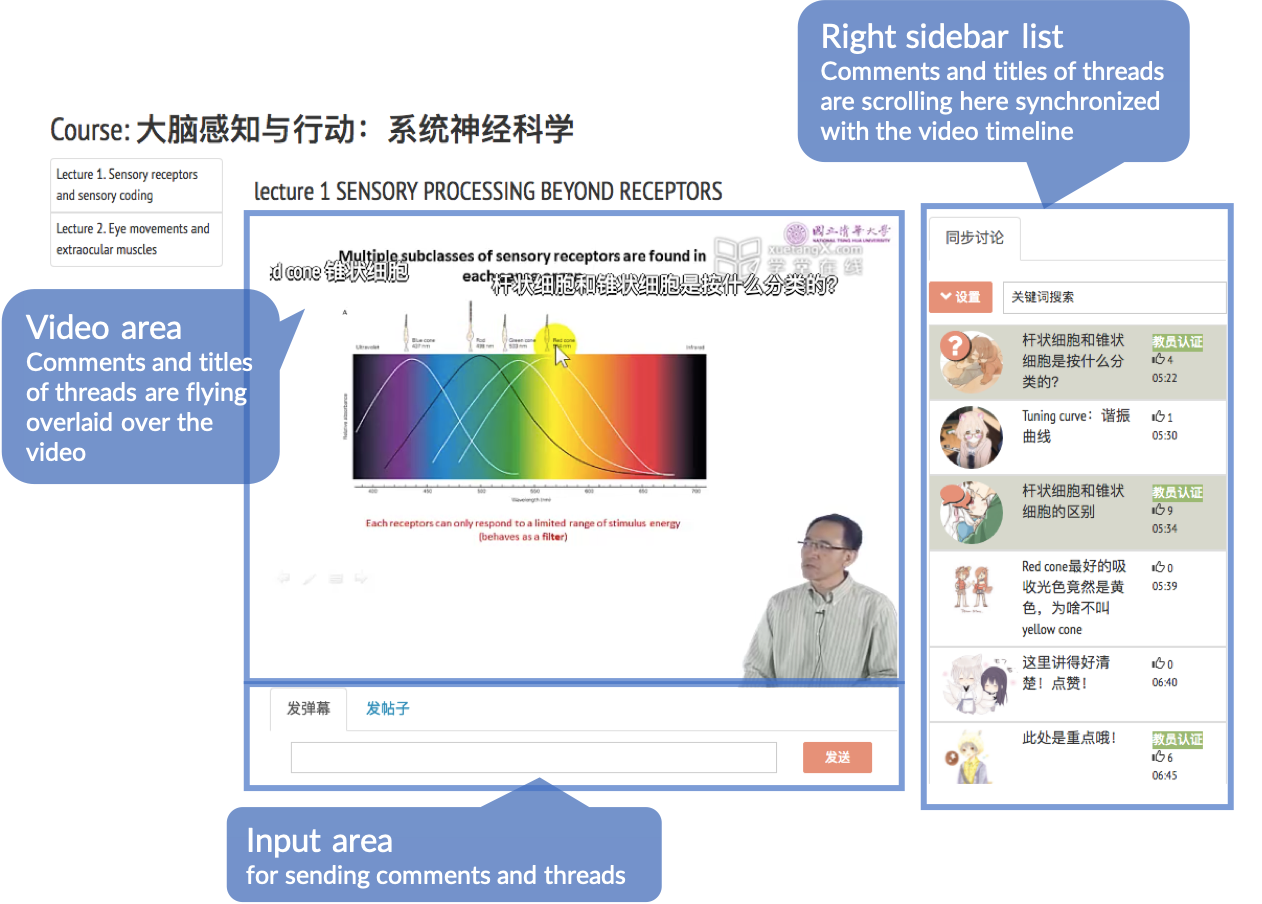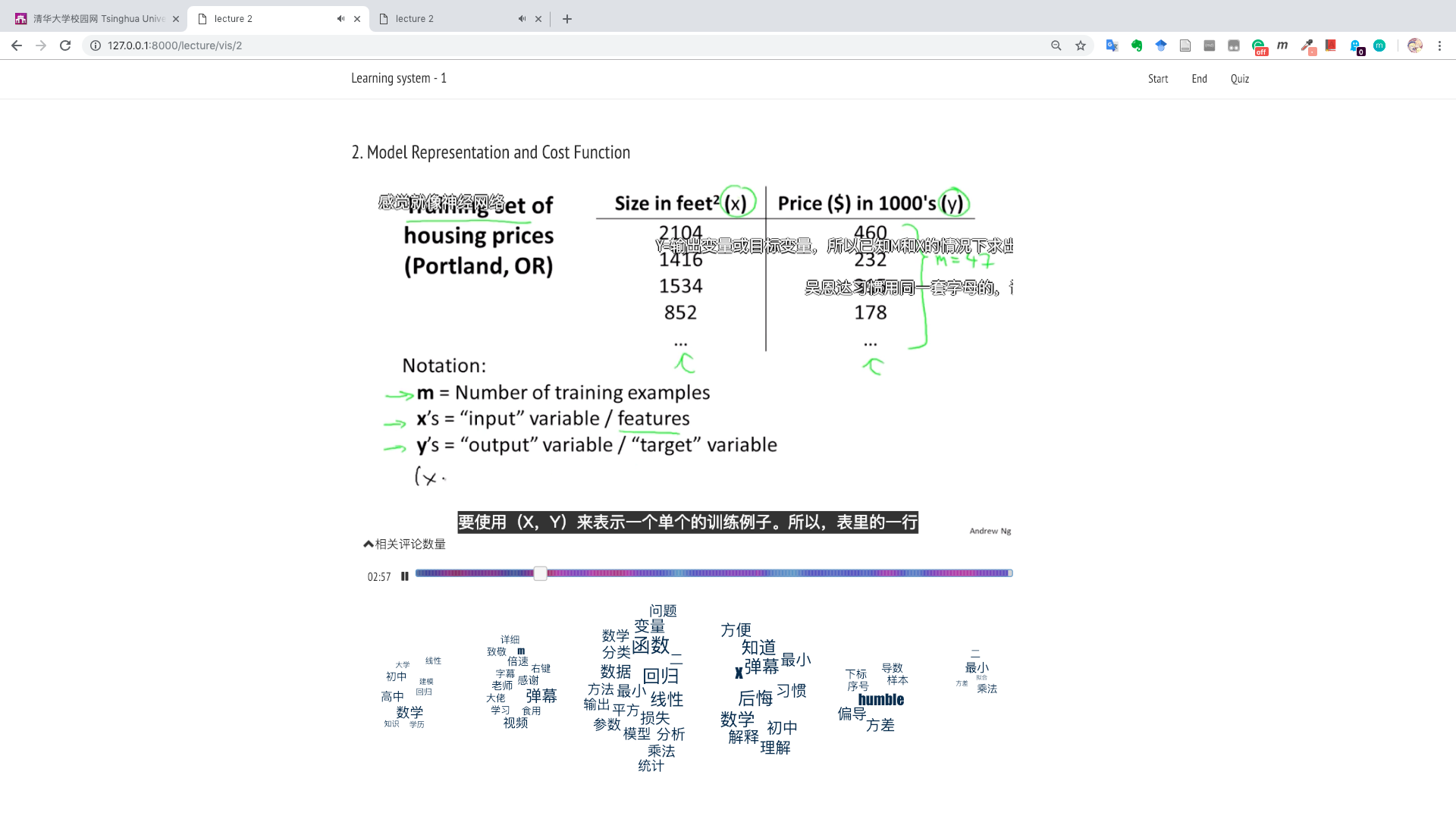Co-viewing and Timeline-anchored Discussion for Connectivity and Learning
Introduction
People like co-viewing videos for information, interaction, and entertainment. To support discussion during viewing online videos, many platforms provide functions of commenting anchored to video timelines. Though the timeline-anchored commenting is asynchronic, it can mimic a synchronic co-viewing experience. It has become popular in China. For example, a timeline-anchored video sharing platform Bilibili has attracted over 130 million active users. Many of them watch timeline-anchored videos for informational purposes or informal learning. Some Bilibili users even reposted lecture videos of Massive Open Online Courses (MOOCs, such as courses on Coursera) and attracted millions of viewing and thousands of comments (e.g., a course about machine learning).
Though timeline-anchored commenting may facilitate interaction, it may also bring visual clutters, information overwhelming, and mental workload. Timeline-anchored comments overlaid on videos are also usually transient and cannot be replyed. Therefore, it is hard to support in-depth discussions during learning.
Therefore, I did a series of studies to design for timeline-anchored discussion and facilitating connectivity and cognitive learning, including the following research questions:
- Gratifications & motivations: Why do people co-view videos with timeline-anchored discussion?
- Cognitive process: How do people process information from videos and comments?
- Design: How to support video viewing and interaction by timeline-anchored discussion?
Gratifications & motivations
First, we conducted a survey study with 646 valid responses to recognize motivations to enroll in MOOCs and how these motivations affected interactions, presence, and learning outcomes. We figured out 1/3 of the participants were asocial learners, who tried to focus on learning materials rather than discussions. Their social presence could increase cognitive learning but decrease satisfaction. It suggested that discussions needed to be more accessible with the useful information highlighted.
Publication: Discuvering MOOC learner motivation and its moderating role
Then, by focus groups and a survey involving 248 valid responses, We clarified how the viewing of timeline-anchored videos was affected by gratifications, hindrances, and viewers’ individual differences. The factor analysis showed that people viewed these videos mainly to obtain entertainment, information, and social connectivity. The hierarchical regressions showed that more introverted younger people with higher openness to new experience are more likely to view more. Polychronicity did not predict attitude or behaviors significantly.
Publication:
- Understanding gratifications of watching Danmaku videos - videos with overlaid comments
- Watching a movie alone yet together: understanding reasons for watching Danamku videos
Cognitive process
Timeline-anchored comments, as user-generated knowledge, facilitate social interaction but also affect cognitive learning. The visual layout of these comments can affect learners’ attention and learning, but the effect has been rarely studied. Therefore, we compares two common layouts (embedded vs. separated) considering the content depth of comments through a laboratory eye-tracking experiment involving 40 participants. The results suggest that, with both the layouts, learners switched attention to the comments every 10 seconds but stayed for 1.3 seconds averagely before backing to the video. With an embedded layout, learners switched more frequently to the comments and remembered more surface-level comments. With a separate layout presenting deep-level comments, learners searched for information faster and performed better on open-book quizzes. We outline the design implications of using timeline-anchored comments to promote online learning. (under revision)
Design
To support discussion during lecture videos, we iteratively designed and evaluated two tools. The first named DanMOOC is a system where viewers can post comments or threads on the video timeline. During the design process, we evaluated prototypes by interviewing 4 teachers, 8 TAs, and 7 students. The final design was evaluated by a laboratory experiment with 28 participants. In this experiment, we compared DanMOOC with a commonly-used platform (lecture videos + a separate forum). The results showed that DanMOOC engaged learners in more discussions, increased social, teaching, and cognitive presence perceived by learners, and improved learners’ satisfaction toward both the course and the platform.
 .
.
Publication:
- DanMOOC: Enhancing Content and Social Interaction in MOOCs with Synchronized Commenting
- Facilitating students’ interaction in MOOCs through timeline-anchored discussion
Second, we designed a comment visualization tool to help retrieve information and reduce the workload of watching lecture videos with timeline-anchored comments. We visualized (1) the level of difficulty and the relevance of comments to the lecture along with the video timeline, and (2) the topics and keywords extracted from comments along with the video timeline. We conducted a within-group experiment with 24 students to compare the video learning platforms with/without this visualization tool (both platforms showed timeline-anchored comments). The results indicated that the visualization tool increased learners’ performance in open-book quizzes, search tasks, and summarization tasks. With this tool, learners also perceived higher social presence. Twenty-two of the 24 students preferred the system with the visualization tool. [working paper, draft available upon request]
 .
.
In addition, we also gathered data of learners’ face expressions during watching lecture videos and discussion comments anchored to the video timeline. Based on these data, we identified and visualized learners’ perceived difficulty and their interest level along with the video timeline by a fused model of CNN (for face expression) and LSTM (for comments).
Summary
This project highlighted both the cognitive and social impacts of timeline-anchored discussion. We identified how timeline-anchored discussions facilitated passive socialization, active participation in discussions, and information retrieval and integration in video viewing and learning. We also proposed and verified innovative designs with visualization techniques. Overall, this project provided valuable references for the design of video learning, video discussion and annotation tools.
